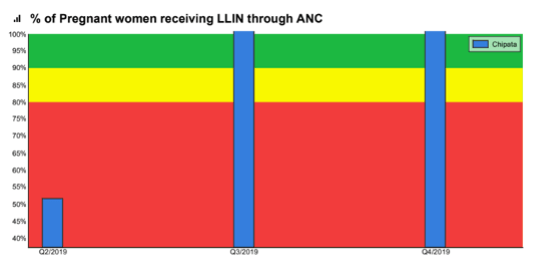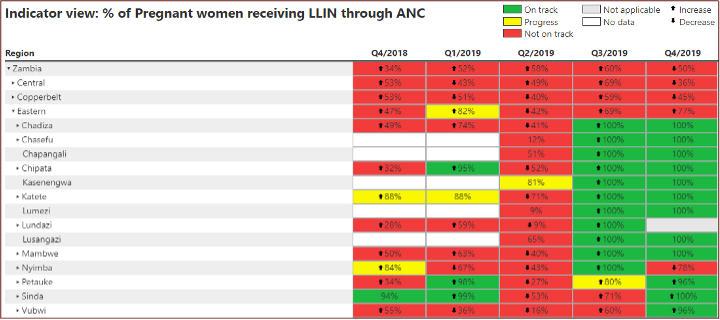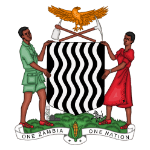Introduction
The malaria burden in Zambia has decreased significantly with the scale-up of control efforts in the past decade, although the disease is still a major public health challenge and remains endemic across all ten provinces. The country’s steady progress in the fight against malaria can be attributed to increased efforts by the Zambian government and partners, as well as the use of innovative tool such as the malaria scorecard management tool.
What is the malaria scorecard management tool?
The scorecard displays performance of priority indicators support action and accountability. The National Malaria Elimination Programme and partners use the scorecard to track progress performance against 11 key malaria indicators nationally and sub-nationally (province, districts) to drive action. Every month, all district health facilities collect and report data on indicators related to case management, vector control and surveillance. This data is collated by the district health information officer (DHIO) and uploaded into Zambia’s Health Management Information system, DHIS2. The National Malaria Elimination Programme (NMEP) M&E officer uses the DHIS2 data to produce the scorecard on a quarterly basis, providing a color-coded snapshot showing the performance of key indicators for discussion at management meetings. Using traffic light colours, the scorecard tool displays performance, with cells showing green when an indicator is on track, yellow when there is progress and red when the indicator is not on track. The scorecard helps identifying underperforming indicator. For example, in Eastern province, during the creation the Q1/2019 online workplan meeting, the scorecard revealed that 12 out of 14 were not on track on the indicator proportion of pregnant women receiving long lasting insecticide treated nets through antenatal care.
Workplan manager
The workplan manager is a new functionality of the scorecard tool, rolled out in 2019, that allows integration and alignment of all activities from government and partners and enables the joint tracking of implementation of the annual workplan, listing key milestones and action items and progress against them. The workplan manager is populated in Q1 during the annual workplan harmonization meeting. All stakeholders (Government, Provinces, Districts and Partners) use this process to align their workplans which in turn are used to review performance, identify and address bottlenecks and drive action. Stakeholders can login to the scorecard webplatform to see progress and quickly identify delayed deliverables. The workplan is discussed at several meetings including weekly management meetings at the province or district, quarterly integrated meetings at the district or province, monthly directorate meetings at the NMEP and quarterly meetings of the End Malaria Council. The Eastern Province has used the workplan during Malaria Taskforce Meetings, and to successfully advocate for LLINs (bed nets) distribution.
The scorecard led to mobilize resources from local partners in the district for fuel to distribute nets. This illustrates the power of the Malaria Scorecard as a tool to promote intersectoral collaboration.
Polite Zulu, District Health Officer Chipata District
How the scorecard led to increased resources and enhanced service delivery in Chipata District
Chipata District Health Office reported achievements in the areas of resource mobilisation through the local Malaria Action Task Force (MATF). The Malaria Task Forces (MATFs) are local multisectoral councils working to mobilise resources and improve planning, implementation, coordination of malaria activities. In Chipata District, The MATF meetings are organised quarterly or ad hoc in case of an emergency and the Scorecard Management Tool has become an integral part of the meetings since the creation of the workplan manager in Q2 2019. The Chipata district MATF Members are District Commissioner, Eastern water and sanitation company, PAMO, District Health Office, DEBS, Vector Link, Ragivale Health Care, Pola Pharmacy, CHAZ, Chipata Muslim Association, District Veterinary Officer, Chipata City Council, Ally and Sons, Chipata Health Care, Kavulamungu Bagain Centre, Eastern Chamber of Commerce, Chipata Central Hospital and World Vision.
At one weekly management meeting, the district health officer review of the workplan and scorecard noted that there was a drop in the proportion of pregnant women receiving Long Lasting Insecticide treated Nets (LLINS) through ANC in Q2/2019. The analysis showed that they had nets in storage at the district which had not been distributed to health facilities. The district health officer used the scorecard to present at the quarterly district malaria task force (MATF) meeting which included participation of local partners and advocate for resources to resolve this bottleneck. Partners in the district responded by contributing to purchase fuel and human resources for the delivery of nets to health facilities. Partners contributed a total of 5500 USD; 1000 ZMW from Ragivale Health Care, 500 ZMW from Ally and Sons, 1000 ZMW from Chipata Health Care, 1000 ZMW from Eastern Water and Sanitation Company and 2000 ZMW from District Health Office. These efforts improved access to nets by pregnant women as reflected in the diagram below comparing Q2 and Q4 2019.
In Q2 of 2019, only 52% percent of pregnant women received long lasting insecticide nets through antenatal care due to a lack of resources in Chipata District. Thanks to the MATFs effort, in Q3 of 2019, the percentage was up to 100%.

The malaria scorecard tool has also become an important management tool that facilitates accountability and action
In Eastern Province, during the process of developing the online workplan for 2019, it was noted that the scorecard indicated consistent poor performance on the proportion of pregnant women receiving long lasting insecticide treated nets through antenatal care in many districts. In Q1 and Q2 of 2019, the number of districts that were flagged in red was high (12 out of 14 districts in Q2/2019) and 1 district in yellow. In order to verify the data, data quality audits were planned, integrated into the workplan and conducted in several districts and health facilities. The analysis revealed issues in recording data at facility level.
The scorecard management tool is fully integrated to the province management mechanisms including the provincial integrated meetings (PIM) at which performance is discussed through analysis of the scorecard and workplan to identify bottlenecks and corrective actions are agreed. Participation is mandatory for all districts and is held every quarter. Prior to participating at the PIM, each district conducts its own District Integrated Management (DIM) meeting at which health centres participate.
Following the results from the Scorecard management tool analysis and the PIM, action was taken to provide mentorship during the province wide technical support and supervision (TSS) missions with positive results as illustrated below, the recorded percentage of pregnant women receiving LLIN through ANC has risen in eastern province from 42% in Q2 to 77% in Q4 2019 with 12/14 districts in green and 1 in red. The Technical Support and Supervision (TSS) is held quarterly by the province or when the need arises.

As a result of reviewing the scorecard, the district conducted Technical Support and Supervisions because of lack of documentation for LLINs given out. Since then, we have seen improvements in terms of numbers of women receiving nets.
Maranatha Kazoka, Data Manager, Sinda District
